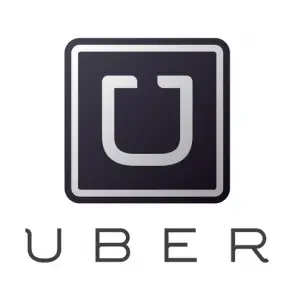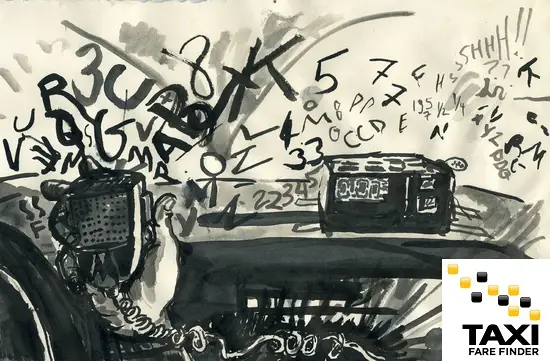When I started driving a taxi back in 1993 cell-phones were a novelty. My first one had to be plugged into the cab’s cigarette lighter and took up a healthy part of the area between the driver’s and passenger’s-side seats. It had a receiver connected by curling cord to a bag which contained the rest of the apparatus (which couldn’t really be moved much if you wanted it to function properly) and a different wire you had to affix to the dash or roof of the car for an antenna. It was a pretty immobile mobile phone; much more akin to a battlefield wireless than what we’re all so used to these days. Nevertheless this cumbersome contraption allowed me to expand my business by allowing regular riders to contact me directly.
For the taxi drivers that came before me there were basically two ways to get fares: street hails and dispatched calls. Mobile phones added a third option. They cut out some of the randomness of picking people up off the street and the frustrations of dealing with taxi company dispatchers (who could make or ruin your night according to their whim or disposition). Driving a cab is a job fraught with chaos so any small measure to introduce order is of great relief. This holds true for the cab passenger as well. My regulars were always grateful to have a driver they could depend on rather than taking a chance on the roulette wheel of raising their hand at the street corner and hoping for the best.
My second phone could be held up to the ear all in one piece. It had a built-in corkscrew-like wire but if you wanted to hear your whole conversation you were better off attaching an external antenna which suction-cupped to the roof. Care had to be taken to attach it while the driver’s door was open, otherwise the whole rig would go flying when I got out of my cab. Texting and apps weren’t anything I could have even conceived of back then but the convenience of cutting out the middle-man that this device allowed was a tiny glimpse into the future.
 When I went back to driving a cab in 2003 cellphones were fairly ubiquitous. Taxi company dispatching had made some strides as well. Though the first company I leased from still used the traditional two-way radios—with the taciturn, squawking voice on the other end—every company after had moved on to Gandalf terminals. This computerized system took much of the blatant abuse and favoritism out of the cab driver-dispatcher relationship. As entertaining as it used to be to hear another driver being ripped a new one publicly for taking too long or not picking up a passenger at all, punching a couple numbers into the terminal and avoiding interference from other drivers or long held grudges with the dispatcher was a godsend. Unlike the old setup where orders went out over the air and could be stolen by other drivers (if they got to the addresses first), the Gandalf only displayed the customer’s address to you. It made the process a bit more even-handed or, at the very least, it kept underhanded behavior out of your face, allowing a driver to get through the long daily hours behind the wheel with a bit less worry and ill feeling.
When I went back to driving a cab in 2003 cellphones were fairly ubiquitous. Taxi company dispatching had made some strides as well. Though the first company I leased from still used the traditional two-way radios—with the taciturn, squawking voice on the other end—every company after had moved on to Gandalf terminals. This computerized system took much of the blatant abuse and favoritism out of the cab driver-dispatcher relationship. As entertaining as it used to be to hear another driver being ripped a new one publicly for taking too long or not picking up a passenger at all, punching a couple numbers into the terminal and avoiding interference from other drivers or long held grudges with the dispatcher was a godsend. Unlike the old setup where orders went out over the air and could be stolen by other drivers (if they got to the addresses first), the Gandalf only displayed the customer’s address to you. It made the process a bit more even-handed or, at the very least, it kept underhanded behavior out of your face, allowing a driver to get through the long daily hours behind the wheel with a bit less worry and ill feeling.
There was one problem that computerized dispatch didn’t solve however: because cab drivers are not employed by the companies they lease their vehicles from, the companies could not compel them to accept the fares that came in. It was entirely up to the driver to accept or reject a call no matter how much the company might beg or cajole. One company I drove with even had an incentive program which rewarded drivers for picking up folks that had been waiting a long time. At the end of each month the ten drivers that had amassed the most of these calls would win cash prizes. It added a fun competitive aspect to the daily slog but was hardly an effective way to service the clientele. The complaints of residents of the city’s under-served areas never seemed to abate.
Sometime in the mid-2000s I noticed a new thing appear. It was called Taxi Magic and with it a customer could summon a taxi through an app on their smartphone. It was a little disconcerting the first time I picked up a couple and they addressed me by my name. The city’s taxi companies all fed their dispatched calls into Taxi Magic, but unlike when you called the cab company for a ride and they’d give you your cab’s number once one had been found, Taxi Magic also included the driver’s name. When you know someone’s name the interaction you have with them becomes much more personal and it’s much easier to give praise or blame where it’s due. If you leave something in the cab, for example, it’s so much simpler to look at your phone and see that you were in Dmitry’s cab and retrace your steps, rather than wracking your brains while calling every cab company in town.
 In 2012, at the end of my cab career, I worked for a bit with Uber. Uber is a smartphone app which connects passengers and drivers through GPS and provides a rating system for both. The people that used the service raved about it because it gave them control over the whole taxi-taking experience that they never felt before. Taxi companies didn’t feel the same way. They considered Uber and other similar services (like Hailo) as a threat, and with good reason. They’ve tried to sue them out of existence by claiming that the newcomers weren’t bound by the same industry rules that they had to live by all these years. I won’t go into the pros and cons of that argument except to say that the dispatching apparatus as set up by the companies and the city was deeply flawed and Uber, et al were offering possible solutions instead of clinging to things as they’d always been for no particular reason aside from fear of change.
In 2012, at the end of my cab career, I worked for a bit with Uber. Uber is a smartphone app which connects passengers and drivers through GPS and provides a rating system for both. The people that used the service raved about it because it gave them control over the whole taxi-taking experience that they never felt before. Taxi companies didn’t feel the same way. They considered Uber and other similar services (like Hailo) as a threat, and with good reason. They’ve tried to sue them out of existence by claiming that the newcomers weren’t bound by the same industry rules that they had to live by all these years. I won’t go into the pros and cons of that argument except to say that the dispatching apparatus as set up by the companies and the city was deeply flawed and Uber, et al were offering possible solutions instead of clinging to things as they’d always been for no particular reason aside from fear of change.
I don’t know if Uber or Hailo is the answer but some such tool is the future of taxi dispatch. By making the driver-customer interaction personal, accountable, and customizable many of the inefficiencies and longstanding problems of the whole experience can be eliminated to a large degree. A driver can no longer claim to be outside your door when he’s actually still a mile away, because you can see his precise position on your phone and you can call him directly and ask him to stop playing games. A passenger can no longer run out without paying because his credit card is on file and the driver will be compensated for his work no matter how far the passenger runs from the cab.
It’s all about taking as much chance and luck out of the process as possible. Will an app make every ride perfect? Of course not, but anything we can do to make the experience of taking a taxi easier should be welcomed with open arms.
This piece was written by guest writer Dmitry Samarov. We would like to thank Dmitry for his input and opinion; your time and support are greatly appreciated. If you would like to learn more about Dmitry’s experiences, check out TaxiFareFinder’s interview conducted in May of 2013. To read more from Dmitry, visit his website: http://www.dmitrysamarov.com/.

